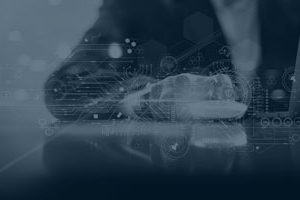Did you ever wonder how some intelligent products are so incredibly good at certain tasks? And did you then wonder how you could do this with one of your products? If you did, then you are at the right place, because in this blog we are diving into the world of continuous learning. We’ll discuss what continuous learning is and how this can be applied to almost any product with our handy roadmap. Whether it’s something as simple as a lamp or as complex as a modern car, we’ve got you covered.

What is continuous learning?
Continuous learning is a paradigm where you keep learning from your own experiences. You can imagine this quite easily within a human context. A set of twins is born, Robert and Jimmy, and except for some genetic automatisms, they still need to learn everything. While growing up these children develop their skills more and more. Intellectually, by going to school where the subjects become more and more complex. Physically, by practicing sports and emotionally, by interacting with people. So far Robert and Jimmy have gone through the same trajectory, but now that they are adults they go their separate ways. Jimmy has the idea that they don’t need to learn anymore, seeing as he has already mastered a few skills. Robert, however, believes that there is always room for improvement and keeps trying to hone his skills.
You can already imagine where this is going, Robert is following the continuous learning paradigm. With his growth mindset he will be able to achieve much more than Jimmy. Jimmy’s fixed mindset is not really a desired trait for anyone, so why should it be desired in machine learning? In other words: whenever it’s possible, continuous learning is desired.
But how can we tailor a product to allow for a continuous learning scheme?
The product life cycle of the future
To make a product follow the continuous learning paradigm we need to break with tradition at a core level, the product lifecycle. Let’s step into our time machine and go to the year 2000. What if we wanted to create a smart heating device? Aside from the obvious mechanics, this device should be outfitted with a thermostat to turn on the heat depending on the desired temperature and the measured room temperature. In order to do so, we need to learn the characteristics of our smart heating device. Therefore, we take it to the lab and do some extensive tests to figure out the ideal settings for the thermostat. Et voilà, our heater is ready for manufacturing and we can start selling it on the market.
Let’s step back into our time machine and return to the present. The goal is still the same, we really want that smart heating device. So we go through the same process as before and create the exact same product. However, we make one important change in the design, we connect it to the internet. Now, while the product is being used by people to warm their cold feet in the winter, we receive data from all these devices. In what temperatures are these devices being used? What temperatures do our clients desire their homes to be? How good are our devices at achieving these room temperatures? As you can see, we can learn a lot about the customers and the device by only making a small change in the design. But we’re not the only ones that can learn from this information. In the lab we kept a copy of the thermostat algorithm, which now can improve further from the experience of all its clones in the field.
Every so often we test this algorithm in the lab and once we see that our heater has become better at keeping us warm, we can roll out a new version of the thermostat. Not only to the heaters still being manufactured, but also to all the heaters in the field through the power of the internet. This way the heaters that have already been sold can also become better over time. If we wanted to do this in the past, we needed to go back to the lab to gather data in order to develop and release a new version. This new version would only be running on the devices that still had to be created. The previously sold heaters keep working with the original thermostat algorithm. This shows us how much of an effect this small change in the design can have.
You might be thinking “Ok, we now have a heater that can improve its thermostat over time, big deal”, but what if I told you that we can do a lot more with this seemingly simple heater.
The continuous learning roadmap
If we would envision the idea of this heater on a timeline we could say that over time the amount of data increases exponentially. First in the lab, then only for a limited group of consumers, and finally moving towards the full market. Now, while the amount of data is increasing we can define a few milestones for our smart heater.
From the get-go we employ the most basic strategy: if the room temperature is below the desired temperature, turn on the heating to the maximum. At the first milestone we can replace this algorithm with an algorithm that takes into account the heating capabilities that were learned from the gathered data. This algorithm won’t turn the heating to the maximum setting if it isn’t necessary.
In the next phase we take our data gathering to the next level. We found that the heating algorithm is still not good enough to market the device as smart. Therefore we go back to the lab and do more extensive experiments. We test the heater in different environments and for all kinds of desired temperatures. Now, we can improve the algorithm to know what the characteristics are of the room in which the heater is located. A larger room warms up more slowly and therefore needs more heat to reach the same temperature as a small(er) room. By recognizing this effect, we can adapt the algorithm and release a limited number of heaters as a sort of beta-test. With the data coming from actual consumers, we can further improve our algorithm. This improved algorithm can then be deployed when we release the smart heater on the market.
Congratulations are in order, our heater is now on the market. Naturally, we don’t want to stop here. With our heaters being used all over, our data collection shifted a few gears higher. Our algorithm can now start to learn to adapt to different climates and different types of houses by taking into account the geographical location of the heater and the time of day. As time goes on we can also make our algorithm learn how to mitigate the aging of our heaters from this data.
And beyond…
Once the machines are in the market, we can start the development of a few completely new features for our heater. These can then be rolled out once they are ready. We can for instance learn the preference of a user, changing the desired temperature automatically in order to achieve the desired temperature by the time the user comes home. Another algorithm could learn to detect a malfunctioning device early and prevent our heaters from catching fire. With more data being collected every day, the options are almost limitless.
In this blog we started from the idea of creating a smart heater where you can set the desired temperature. Finally, we ended up with a high-tech device that knows beforehand when you are going to increase the desired temperature. To be able to do so, we used a state-of-the-art product lifecycle where we continuously collect data and improve the intelligence of the application. The crazy thing is that this is applicable to almost any product you can imagine. With that thought, I hope you now have a better understanding of how this continuous learning paradigm is changing the world around us and how you can be a part of this revolution.
Looking for more interesting insights on artificial intelligence? Check out our blog and perspectives!




